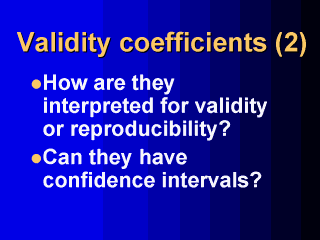| front |1 |2 |3 |4 |5 |6 |7 |8 |9 |10 |11 |12 |review |
 |
The method with the highest validity
coefficient (0 to 1) is considered to have measurements closer to the true, but unknown,
exposure values and is therefore preferred. Because of the assumption that if all
methods were valid they should give equal VCs, we can use these estimates to comment
on which method performed better. The method with the highest VC is considered more valid!
In other cases one method (e.g. the field method) may be repeated (e.g. after a year) to give two values (e.g. Q1 and Q2). Then, as before, compute VCs first using Q1 alone and secondly using Q2. In a case where the method is reproducible, we would expect the VCs obtained using Q1 measurement to be equal to those obtained using Q2 measurements. This is the assessment of reproducibility using the method of triads. Various methods are available for constructing confidence intervals about the VCs. One easy to execute method is the bootstrap method. Here samples of equal size are randomly drawn (with replacement) from the validation study sample for about 500-1000 iterations. Validity coefficients are computed from each sub-sample resulting in a data set with 500-1000 observations (each observation containing a VC for each method). The 5th and 95% percentiles can be computed and used as nonparametric confidence intervals (see references). |